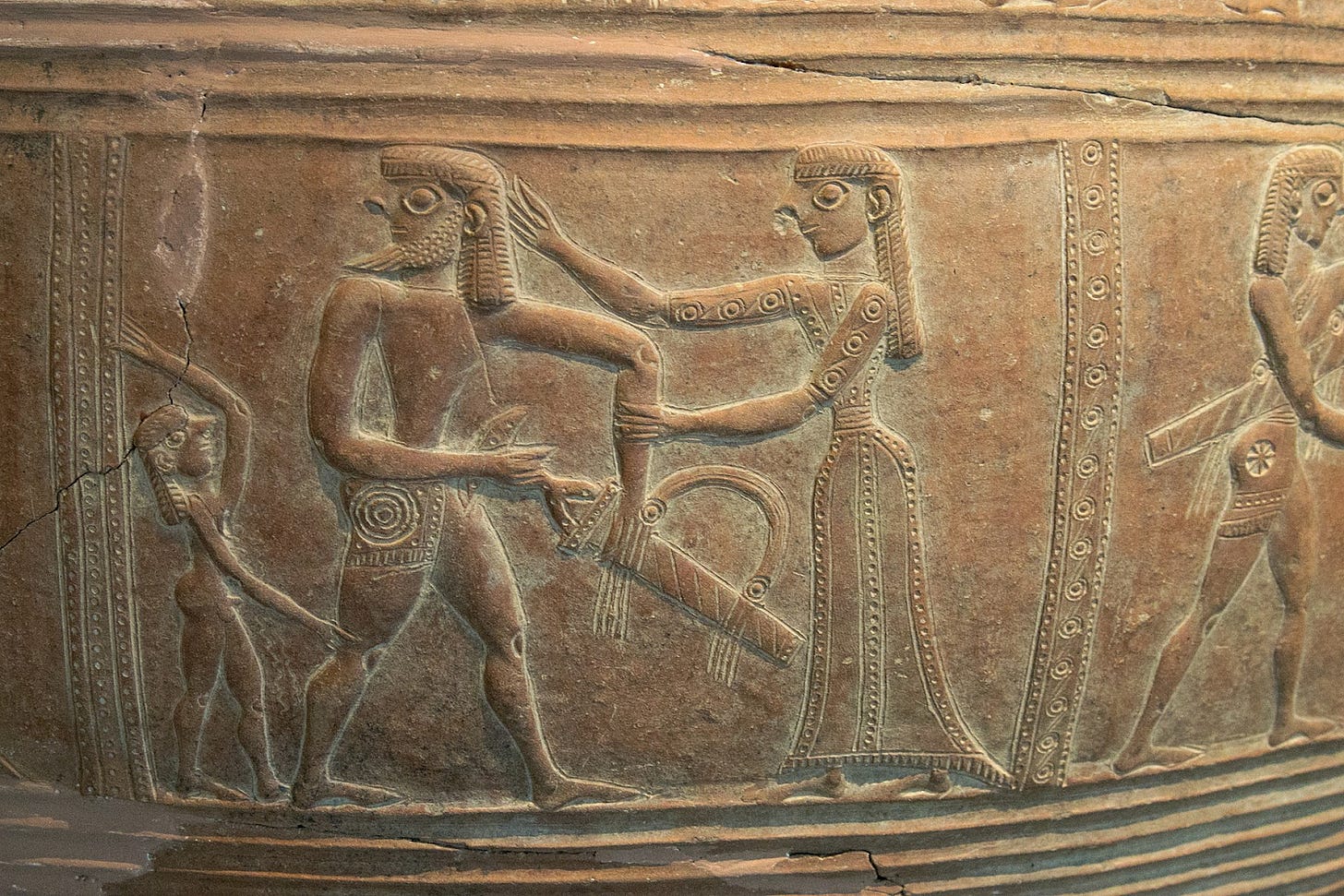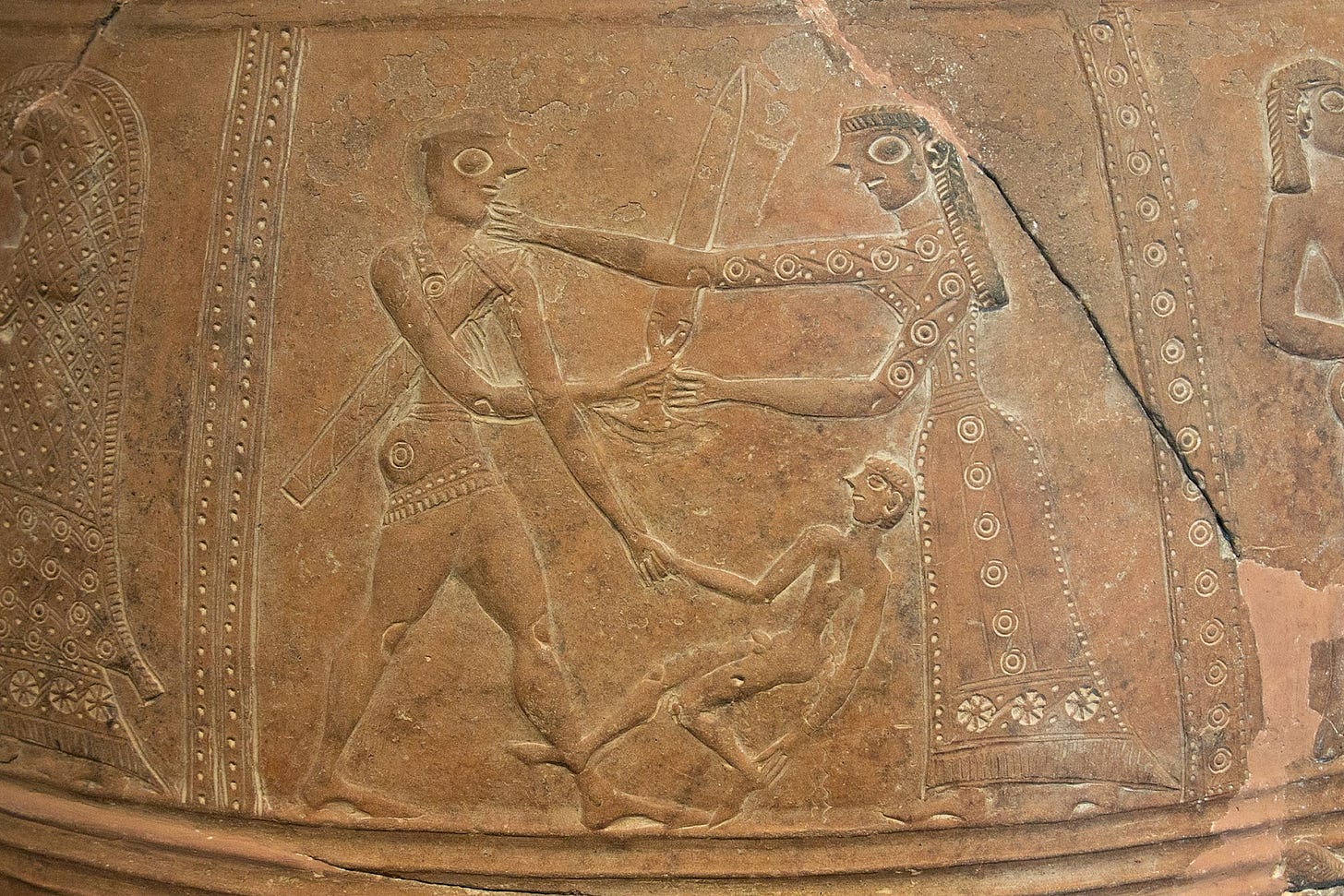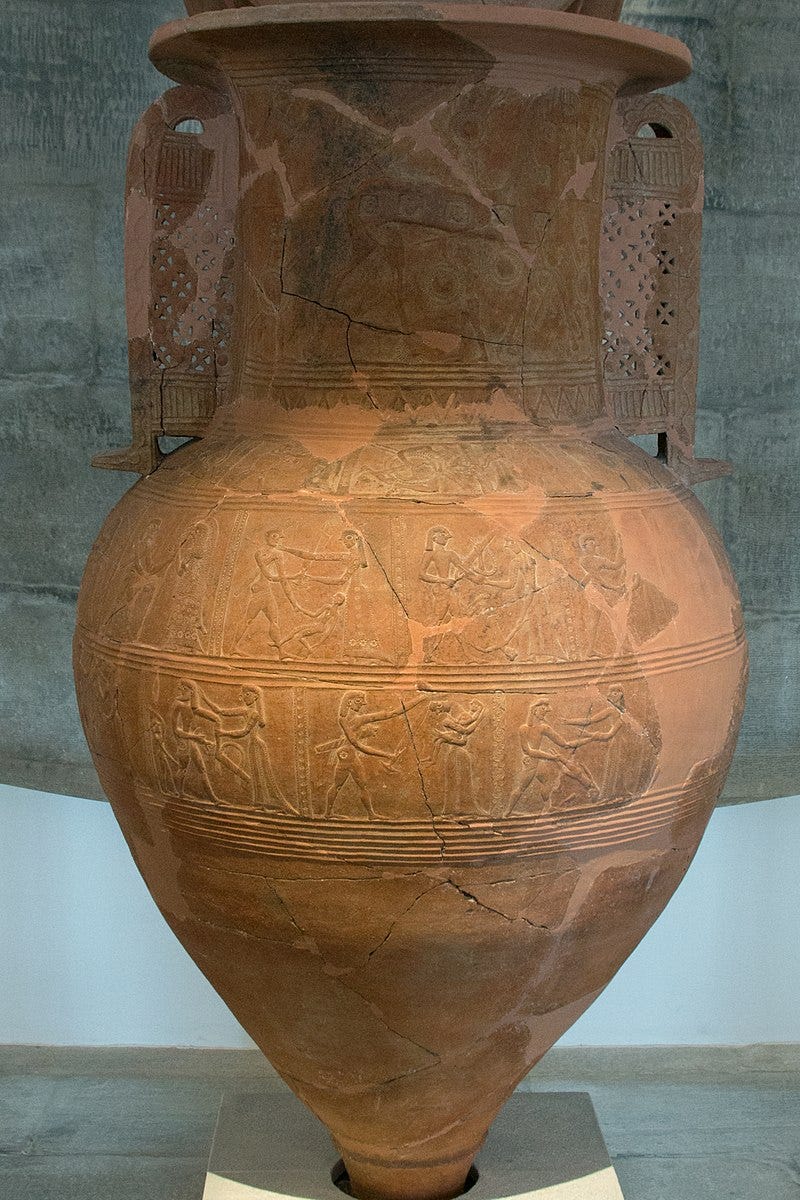Reminder: all proceeds from the substack are donated to classics adjacent non-profits on a monthly basis.
CW: Infanticide, Sexual Violence. Reference to current events.
Iliad 6 picks up at the end of book 5, where Diomedes enjoyed his aristeia. The audience witnesses a series of Achaean kills, before focusing on an exchange between Menelaos and Agamemnon. Menelaos has captured the Trojan Adrastus alive and was about to send him to the ships to be ransomed later. Agamemnon intervenes:
Homer, Iliad 6.53-62
“And then [Menelaos] was intending to give Adrastus
To an attendant to take back to the Achaeans’ swift ships
But Agamemnon came rushing in front of him and spoke commandingly
“Oh my fool Menelaos, why do you care so much about people?
Did your house suffer the best treatment by the Trojans?
Let none of them flee dread death at our hands,
Not even a mother who carries in her womb
a child that will be a boy, let not one flee, but instead
Let everyone at Troy perish, unwept and unseen.”The hero spoke like this and changed his brother’s mind,
καὶ δή μιν τάχ᾽ ἔμελλε θοὰς ἐπὶ νῆας Ἀχαιῶν
δώσειν ᾧ θεράποντι καταξέμεν: ἀλλ᾽ Ἀγαμέμνων
ἀντίος ἦλθε θέων, καὶ ὁμοκλήσας ἔπος ηὔδα:
‘ὦ πέπον ὦ Μενέλαε, τί ἢ δὲ σὺ κήδεαι οὕτως
ἀνδρῶν; ἦ σοὶ ἄριστα πεποίηται κατὰ οἶκον
πρὸς Τρώων; τῶν μή τις ὑπεκφύγοι αἰπὺν ὄλεθρον
χεῖράς θ᾽ ἡμετέρας, μηδ᾽ ὅν τινα γαστέρι μήτηρ
κοῦρον ἐόντα φέροι, μηδ᾽ ὃς φύγοι, ἀλλ᾽ ἅμα πάντες
Ἰλίου ἐξαπολοίατ᾽ ἀκήδεστοι καὶ ἄφαντοι.ὣς εἰπὼν ἔτρεψεν ἀδελφειοῦ φρένας ἥρως
I have always struggled with how to understand the rally for widespread infanticide in this scene. On one level, we can see it as typical of Agamemnon: he refused the convention of supplication and ransom in book 1 and refuses to honor a similar supplication by twins in book 11 (122-147). Or, we could imagine that the extremity of the war and Achilles’ rage has upended convention. According to the latter argument, these kinds of violence may be seen as exceptional consequences of enmity and anger. In support of this, consider how Achilles also refuses to honor a suppliant in book 221 (Lykaon) and proceeds to capture 12 Trojan youths alive in order to sacrifice them at Patroklos’ pyre. One of the main thematic arcs of the Iliad is the reaffirmation of social conventions of exchange (ransom/xenia) and the rites of the dead, resolved powerfully in book 24.
But there’s something else going on throughout the Iliad too: an exploration of the limits of violence. Agamemnon does not just advocate for the killing of an armed combatant, he announces a strategy that we might call genocidal today. Indeed, if we look at it carefully, the Iliad is rather clear about what the Trojans can expect at the end of the war. Earlier, Nestor makes it clear that sexual assault is an incentive for his soldiers and a punishment for the Trojan women:
Homer, Iliad 2.354–356
“So let no one be compelled to return home,
Before each one has taken a Trojan wife to bed
As payback for the struggles and moans of Helen”τὼ μή τις πρὶν ἐπειγέσθω οἶκον δὲ νέεσθαι
πρίν τινα πὰρ Τρώων ἀλόχῳ κατακοιμηθῆναι,
τίσασθαι δ’ ῾Ελένης ὁρμήματά τε στοναχάς τε.
Much later in the epic, Priam lets Hektor know what he expects to see when the city falls:
Homer, Iliad 22.59-65
“Pity your unlucky father as he still ponders his
Misfortune., a man father Zeus ruins with harsh fate
Just on the threshold of old age, watching so many evils:
Sons murdered and daughters dragged off,
Bedrooms plundered, and infant children
Hurled to the ground in the awful violence,
While their mothers are hauled away in the Achaeans’ ruinous hands.”πρὸς δ’ ἐμὲ τὸν δύστηνον ἔτι φρονέοντ’ ἐλέησον
δύσμορον, ὅν ῥα πατὴρ Κρονίδης ἐπὶ γήραος οὐδῷ
αἴσῃ ἐν ἀργαλέῃ φθίσει κακὰ πόλλ’ ἐπιδόντα
υἷάς τ’ ὀλλυμένους ἑλκηθείσας τε θύγατρας,
καὶ θαλάμους κεραϊζομένους, καὶ νήπια τέκνα
βαλλόμενα προτὶ γαίῃ ἐν αἰνῇ δηϊοτῆτι,
ἑλκομένας τε νυοὺς ὀλοῇς ὑπὸ χερσὶν ᾿Αχαιῶν.
Agamemnon’s words in book 6 are especially powerful because the invocation of killing infants sets the audience up, in a way, for seeing Astyanax at the end of the book. Hektor’s young son, who had to be conceived and born during the siege and who has likely never left the confinements of his city, is famously killed by either Neoptolemus or Odysseus, dashed to the ground or hurled from the city walls.
A scholiast sees Priam’s words as directly evoking the scenes of the end of Troy:
Schol bT ad Il. 22.61-5a ex.
“And even though he does not describe the sack of Troy, he still makes its suffering clear by summarizing what an entire generation experiences in war.
The outrage against women’s bodies is greater. The poet sublimely offers these things to see only briefly, using the words together and simply. For he doesn’t call the bedrooms “high roofed” or “well-made” or call the daughters “fine-haired” or “nice-ankled”. Instead he [communicates their] misfortune by refraining from the epithets.”
καὶ μὴ γράψας δὲ τὴν ᾿Ιλίου πόρθησιν ὅμως ἐδήλωσεν αὐτῆς τὰ παθήματα, πᾶσανἡλικίαν τὴν ἐν πολέμῳ τι πάσχουσαν παραλαβών· ταῖς δὲ γυναιξὶν ἡ εἰς τὸ σῶμα ὕβρις μείζων. δαιμονίως δὲ ταῦτα ὑπ'ὄψιν ἤγαγεν ἐν βραχεῖ, χρησάμενος ἅμα καὶ ἀπεριέργως ταῖς λέξεσιν·οὐ γὰρ ὑψορόφους ἢ δαιδαλέους θαλάμους λέγει (cf. 63) οὐδὲ θύγατραςκαλλικόμους ἢ καλλισφύρους ἀλλ' ἀπήλλακται τῶν ἐπιθέτων αὐτῷ τὰ δυστυχοῦντα τῶν σωμάτων.
The knowledge of the end of the city and Astyanax’s fate shapes our reception of book 6 and makes the pathos of Hektor’s prayer for his future even harder to handle. How should feel about Agamemnon is contained in the structure of Iliad 6:.his desire to kill all the babies is individualize in one we can understand, similar to the catalogs of obituaries but different: Astyanax is a metonym for all the babies who die at the fall of Troy. Our pity for him should help us to frame and reject Agamemnon's bloodlust. But my concern here is less the narrative structures than on the reflection on the realities of violence. The Iliad is often hard to read when it comes to its violence: the death scenes in particular are vivid and at times even amusingly over-the-top, to my taste more akin to the excess of a Quentin Tarantino movie than the brutal realism of the opening sequence of Saving Private Ryan.
But my thinking about the relationship between the way we talk about Homeric heroes without fully acknowledge the damage they do has changed after spending the last two decades watching bloody conflicts unfold on television and social media.
The End of Troy on the Mykonos Vase
As I was reading through book 6, I went to do an image search for the death of Astyanax. In the worst version of this motif, the infant child is used to beat his grandfather Priam to death.
I then was wondering about the iconography of this scene and googled infanticide and found this on Wikimedia commons:
I was somewhat shocked that I had never seen this image from a Greek vase before. I then realized that it was part of a series of panels that tell the story of this child, a warrior, and his mother. It may be different scenes of an attack, or a sequence telling a story.
What seems to happen in this sequence is that the small child tries to intervene when the soldier approaches his mother.
Then the soldier sees the child and grabs him.
And runs him through with his sword.
Due in part to the news and being a parent, I found this series really upsetting. But what upset me more was when I looked at the whole vase. I have shown pictures of the top portion of this vessel dozens of times in my career because it is the oldest known image of the Trojan horse. I always used to make jokes about the soldiers looking out the windows. How could the Trojans be so dumb as to let them in?!
The terrible violence on the lower part of the vase seems a consequence of the actions of the warriors inside the horse. But the relationship between how we treat that amusing image and the violence below is a close analogy for what we do with the Iliad by focusing on its heroic veneer without really dwelling enough on the horrors of the world it depicts.
Michael Anderson (1997, 183-191) discusses the pithos in detail as an example of the plot of the lost poem the Iliou Persis. According to Anderson (see also Ervin 1963), the panels follow the action of a single warrior and woman with a male child in different poses, indicating a narrative. He summarizes “This conglomeration of panels exposes an operation of mass enslavement and extermination.” He compares the panels to Priam imagining the future death of his sons and enslavement of daughters in book 22 (62-65). He adds “But the massacre on the pithos need not be limited to a single family, and the multiplication of scenes may be read as an attempt to represent all the women and children of the city” (186) and adds “... the warriors on the pithos are determined to eradicate the entire race of Trojans, and all the male children must die, even the sons still in the womb, as Agamemnon coldly threatens in Iliad 6” (187).
But I fear that the relegation of these images to a particular story tradition does not help us understanding what audiences did with them. As Kathy Gaca shows in her article “The Andrapodizing of War Captives in Greek Historical Memory,” the act of killing those who know how to fight and enslaving/taking those who do not (women and children) was a practice observed in many different ways in Ancient Greece. Agamemnon’s words and the Mykonos vase must surely reflect these practices. I don’t think they are celebrating them, but the tone is far too unclear.
A coda
The Iliad is in part the story of ‘civilizing’ conventions of wars dismissed. What we learn from the beginning is that political institutions are not strong enough to enforce the maintenance of normative behaviors. The personal decisions of individuals–Paris before the war, Agamemnon at the beginning of the Iliad–run roughshod across principles of ransom in exchange for life that the assembled Greeks cheer for in book 1.
The story of excessive violence in the Iliad is that of the rejection of conventions meant to make war in some way predictable and ‘acceptable’ to the combatants. The planned sexual violence of the Achaeans, the rejection of ransom-exchange, and the promotion of infanticide all come within the frame of the breakdown of political control over individual behavior. ‘Rage’ is the break from limitations enforced by social conventions; it unleashes the true hell of war and unveils the brutal, dehumanizing violence pulsating beneath the service of ‘civilization’.
Even the epic’s conclusion is compromised: the cessation of Achilles’ rage only comes through monstrous behavior (corpse-disfigurement and human sacrifice) and occurs at the personal level between a bereft father and a surrogate son whose potential for violence has ebbed through exhaustion and divine intervention. It thematically seals the epic’s arc: book 1 saw the breakdown in social convention thanks to the whims of an angry king; book 24 sees the conventions briefly reinforced, thanks to the needs of two kings in despair. Yet their attitude is not one of rejection violence or rehabilitation, but resignation to the continuing war that will take both of their lives.
For a marginally more explicit take on current events, see here.
Some things to read
n.b this is not an exhaustive bibliography. If you’d like anything else included, please let me know.
Anderson, Michael J. 1997 The Fall of troy in Early Greek Poetry and Art Oxford
Ebbinghaus, Susanne. “Protector of the City, or the Art of Storage in Early Greece.” The Journal of Hellenic Studies 125 (2005): 51–72. http://www.jstor.org/stable/30033345.
M. Ervin, “A relief pithos from Mykonos”, Archaiologikon Deltion 18 (1963), pp. 37-75.
Gaca, Kathy L. “Reinterpreting the Homeric Simile of ‘Iliad’ 16.7-11: The Girl and Her Mother in Ancient Greek Warfare.” The American Journal of Philology 129, no. 2 (2008): 145–71. http://www.jstor.org/stable/27566700.
GACA, KATHY L. “The Andrapodizing of War Captives in Greek Historical Memory.” Transactions of the American Philological Association (1974-) 140, no. 1 (2010): 117–61. http://www.jstor.org/stable/40652052.
Gaca, Kathy L. “MARTIAL RAPE, PULSATING FEAR, AND THE SEXUAL MALTREATMENT OF GIRLS (Παῖδες), VIRGINS (Παρθένοι), AND WOMEN (Γνναῖκες) IN ANTIQUITY.” The American Journal of Philology 135, no. 3 (2014): 303–57. http://www.jstor.org/stable/24560257.
Sparkes, B. A. “The Trojan Horse in Classical Art.” Greece & Rome 18, no. 1 (1971): 54–70. http://www.jstor.org/stable/642388.











Curiously, in the passage right after Agamemnon's command to commit infanticide, as it were, the Homeric narrator speaks of this, "αἴσιμα παρειπών:" "appointed by the will of the gods, destined,"- Wilson translating this as "to do what must be done" - the consensus, if any, of English translation is that Agamemnon is persuading the otherwise gentle Menelaus to do some grim duty, even if it's less pleasant to just capture the soldier and then sell him back for a heavy ransom.
So even where the Iliad may critique extreme military violence, I'm not entirely sure it condemns it, and I think this may apply also to Achilles' more extreme behavior in the moment of his return to battle.
From Graziosi and Haubold:
“αἴσιμα παρειπών ∼ 7.121, ‘advising what was apportioned’; cf. 333n. (κατ᾽ αἶσαν…οὐδ᾽ ὑπὲρ αἶσαν). A problematic addition which has challenged ancient and modern readers (e.g. Goldhill 1990: 376); as elsewhere, the poet invites scrutiny of Agamemnon's behaviour (see esp. 2.1–420). Ancient commentators wondered whether αἴσιμα simply means ‘in accordance with fate’ (ΣT ad 6.62a), or whether the poet endorses Agamemnon's speech as ‘appropriate’, even though it seems especially savage (ΣbT ad 6.62a, cf. 58–60n.). As Kirk 1990: 191 points out, ‘αἴσιμα…refers to Agamemnon's invocation of the laws of hospitality in 56 more than anything else’; see esp. Od. 15.68–71. ΣbT ad 6.58–9b argue that the speech is appropriate, because the truce has been broken: at 3.300–1, Trojans and Achaeans agreed that, should they break the truce, they ought to have ‘their brains poured out like wine, and those of their sons too, and their wives raped’. For further discussion, see esp. Fenik 1986: 26; Yamagata 1994: 118; Wilson 2002: 166–7; Stoevesandt 2004: 152–5."
This is fantastic Joel. A topic that I am so interested in and so insightful and relevant as always. I'm going to edit something I just submitted!